Microstructure and Mechanical Properties of Fe-36Ni and 304L Dissimilar Alloy Lap Joints by Pulsed Gas Tungsten Arc Welding
Abstract
:1. Introduction
2. Experimental Procedure
3. Results and Discussion
3.1. Macro-Morphology of the Welded Joints
3.2. Microstructure of the Lap Joints
3.3. Microhardness
3.4. Tensile Properties
4. Conclusions
- (1)
- There are no visible defects such as void and cracks in the Fe-36Ni/304L lap joint.
- (2)
- The feature size La and P changed slightly, while R showed an increasing trend and α showed
- (3)
- A decreasing trend with the increase of pulse frequency.
- (4)
- Fusion zone is mainly composed of γ phase and M23C6, and M23C6 particles are distributed on the grain boundaries of the cells.
- (5)
- The microhardness of the fusion zone is the lowest in the entire welded joint, with an average hardness between 110 HV1 and 136 HV1.
- (6)
- The tensile force of Fe-36Ni/304L lap joint has a high positive correlation with the characteristic dimension R. The average maximum tensile force is 11.95 kN when the pulse frequency is 15 Hz.
Author Contributions
Funding
Acknowledgments
Conflicts of Interest
References
- Park, W.S.; Chun, M.S.; Han, M.S.; Kim, M.H.; Lee, J.M. Comparative study on mechanical behavior of low temperature application materials for ships and offshore structures: Part I-Experimental investigations. Mater. Sci. Eng. A 2011, 528, 5790–5803. [Google Scholar] [CrossRef]
- Zhan, X.; Meng, Y.; Zhou, J.; Qi, C.; Zhang, C.; Gu, D. Quantitative research on microstructure and thermal physical mechanism in laser melting deposition for Invar alloy. J. Manuf. Process. 2018, 31, 221–231. [Google Scholar] [CrossRef]
- Mirshekari, G.R.; Tavakoli, E.; Atapour, M.; Sadeghian, B. Microstructure and corrosion behavior of multipass gas tungsten arc welded 304L stainless steel. Mater. Des. 2014, 55, 905–911. [Google Scholar] [CrossRef]
- Baghjari, S.H.; AkbariMousavi, S.A.A. Experimental investigation on dissimilar pulsed Nd: YAG laser welding of AISI 420 stainless steel to kovar alloy. Mater. Des. 2014, 57, 128–134. [Google Scholar] [CrossRef]
- Wu, S.; Ju, Y.; Lin, J.; Fu, Y. Numerical simulation and experiment verification of the static boil-off rate and temperature field for a new independent type B liquefied natural gas ship mock up tank. Appl. Therm. Eng. 2020, 712, 115–265. [Google Scholar] [CrossRef]
- Li, D.L. Study on Automatic TIG Welding of Invar Alloy at Vertical Position. Master’s Thesis, Tianjin University, Tianjin, China, 2016. [Google Scholar]
- Shakil, M.; Ahmad, M.; Tariq, N.H.; Hasan, B.A.; Akhter, J.I.; Ahmed, E.; Mehmood, M.A.; Choudhry, M.A.; Igbal, M. Microstructure and hardness studies of electron beam welded Inconel 625 and stainless steel 304L. Vacuum 2014, 110, 121–126. [Google Scholar] [CrossRef]
- Zhao, D.S.; Huang, Z.Y.; Liu, Y.J.; Miao, T. A Study of the Effect of Post-Heating Pulse on Hot Cracking Susceptibility in Pulsed Laser Welding of Invar Alloy. J. Ship Prod. Des. 2019, 35, 338–343. [Google Scholar] [CrossRef]
- Wei, K.; Yang, Q.D.; Ling, B.; Yang, X.; Xie, H.; Qu, Z.; Fang, D. Mechanical properties of Invar 36 alloy additively manufactured by selective laser melting. Mater. Sci. Eng. A 2020, 772, 138799. [Google Scholar] [CrossRef]
- Ni, J.M.; Li, Z.G.; Wu, Y.X. Hot tearing susceptibility of high speed laser welding invar sheet. Chin. J. Lasers 2011, 38, 82–86. [Google Scholar]
- Cheepu, M.; Venkateswarlu, D.; Rao, P.N.; Muthupandi, V.; Sivaprasad, K.; Che, W.S. Microstructure Characterization of Superalloy 718 during Dissimilar Rotary Friction Welding. Mater. Sci. Forum 2019, 969, 211–217. [Google Scholar] [CrossRef]
- Yan, F.; Fang, X.; Chen, L.; Wang, C.; Zhao, J.; Chai, F.; Wang, W. Microstructure evolution and phase transition at the interface of steel/Al dissimilar alloys during Nd: YAG laser welding. J. Opt. Laser Technol. 2018, 108, 193–201. [Google Scholar] [CrossRef]
- Naffakh, H.; Shamanian, M.; Ashrafizadeh, F. Microstructural evolutions in dissimilar welds between AISI 310 austenitic stainless steel and Inconel 657. J. Mater. Sci. 2010, 45, 2564–2573. [Google Scholar] [CrossRef]
- Montanari, R.; Filacchioni, G.; Riccardi, B.; Tata, M.E.; Costanza, G. Characterization of Eurofer-97 TIG-welded joints by FIMEC indentation tests. J. Nucl. Mater. 2004, 329–333, 1529–1533. [Google Scholar] [CrossRef]
- Lee, H.T.; Lin, Y.D. Microstructure and corrosion behaviour of alloy 690-SUS 304L butt joints formed by electron beam welding. Sci. Technol. Weld. Join. 2006, 11, 650–656. [Google Scholar] [CrossRef]
- Guo, X.; Liu, W.; Wang, C. Numerical Analysis of Elastic-Plastic Deformation Evolution and Fracture Behavior in Tensile Process of Laser Lap Welded 301L Joints. Chin. J. Lasers 2018, 3, 54–67. [Google Scholar]
- Wang, H.; Hu, S.; Shen, J.; Li, D.; Lu, J. Effect of duty cycle on microstructure and mechanical properties of pulsed GTAW lap joint of Invar. J. Mater. Process. Technol. 2017, 243, 481–488. [Google Scholar] [CrossRef]
- Rahimi, A.; Shamanian, M. The PC-GTAW of Ti–6Al–4V Thin Sheets and Its Effects on Mechanical and Microstructural Properties. Metallogr. Microstruct. Anal. 2019, 8, 871–879. [Google Scholar] [CrossRef]
- Moganraj, A.; Devendranath, R.K.; Arivazhagan, N. Effect of Continuous and Pulsed Current on the Metallurgical and Mechanical Properties of Gas Tungsten Arc Welded AISI 4340 Aeronautical and AISI 304 L Austenitic Stainless Steel Dissimilar Joints. Mater. Res. 2015, 18, 59–77. [Google Scholar]
- Ramkumar, K.D.; Joshi, V.; Pandit, S.; Agrawal, M.; Kumar, O.S.; Periwal, S.; Arivazhagan, N. Investigations on the microstructure and mechanical properties of multi-pass pulsed current gas tungsten arc weldments of Monel 400 and Hastelloy C276. Mater. Des. 2014, 64, 775–782. [Google Scholar] [CrossRef]
- Feng, J.; Zhang, H.; He, P. The CMT short-circuiting metal transfer process and its use in thin aluminium sheets welding. Mater. Des. 2009, 30, 1850–1852. [Google Scholar] [CrossRef]
- Joseph, A.; Harwig, D.; Farson, D.F.; Richardson, R. Measurement and calculation of arc power and heat transfer efficiency in pulsed gas metal arc welding. Sci. Technol. Weld. Join. 2003, 8, 400–406. [Google Scholar] [CrossRef]
- Madadi, F.; Ashrafizadeh, F.; Shamanian, M. Optimization of pulsed TIG cladding process of stellite alloy on carbon steel using RSM. J. Alloy Compd. 2011, 510, 71–77. [Google Scholar] [CrossRef]
- Liu, J.W.; Rao, Z.H.; Liao, S.M.; Tsai, H.L. Numerical investigation of weld pool behaviors and ripple formation for a moving GTA welding under pulsed currents. Int. J. Heat Mass Transf. 2015, 91, 990–1000. [Google Scholar] [CrossRef]
- Zhang, Y.; Lu, F.; Wang, H.P.; Wang, X.; Cui, H.; Tang, X. Reduced hot cracking susceptibility by controlling the fusion ratio in laser welding of dissimilar Al alloys joints. J. Mater. Res. 2015, 30, 993–1001. [Google Scholar] [CrossRef]
- Muthupandi, V.; Bala Srinivasan, P.; Seshadri, S.K.; Sundaresan, S. Effect of weld metal chemistry and heat input on the structure and properties of duplex stainless steel welds. Mater. Sci. Eng. A 2003, 358, 9–16. [Google Scholar] [CrossRef]
- Kou, S. Welding Metallurgy, 2nd ed.; John Wiley & Sons, Ltd.: Hoboken, NJ, USA, 2003; pp. 145–169. [Google Scholar]
- Ding, K.; Ji, H.J.; Liu, X.; Wang, P.; Zhang, Q.L.; Li, X.H.; Gao, Y.L. Prevention of carbon migration in 9% Cr/CrMoV dissimilar welded joint by adding tungsten inert gas overlaying layer. J. Iron Steel Res. Int. 2018, 25, 847–853. [Google Scholar] [CrossRef]
- Zhang, X.H.; Chen, J.Q.; Zhang, K.; Chen, H. Study on Grain Refinement of Nickel-Based Filler Metal 52M Microstructure by Pulse TIG Welding. In Proceedings of the International Conference on Mechatronics Engineering & Information Technology (ICMEIT 2017), Dalian, China, 13–14 May 2017. [Google Scholar]
- Li, N.; Zhang, L.; Zhang, R.; Yin, P.; Xing, H.; Wu, H. Research on Grain Refinement in Hypoeutectic Al-Si Alloy during Solidification under an Alternating Electric Current Pulse. Metals 2019, 9, 571. [Google Scholar] [CrossRef] [Green Version]
- Anbarasan, N.; Jerome, S.; Suresh, G.; Oyyaravelu, R. Effect of Pulse Frequency on Microstructural and Corrosion Properties of Inconel 718 Gas Tungsten Arc Weldments. Trans. Indian Inst. Met. 2019, 72, 1299–1311. [Google Scholar] [CrossRef]
- Shao, L.; Wu, S.; Datye, A.; Zhao, H.; Petterson, M.; Peng, W. Microstructure and mechanical properties of ultrasonic pulse frequency tungsten inert gas welded Ti-22Al-25Nb (at.%) alloy butt joint. J. Mater. Process. Technol. 2018, 259, 416–423. [Google Scholar] [CrossRef]
- Zhao, G.; Du, J.; Wei, Z.; Geng, R.; Xu, S. Numerical analysis of arc driving forces and temperature distribution in pulsed TIG welding. J. Braz. Soc. Mech. Sci. Eng. 2019, 41, 1–9. [Google Scholar] [CrossRef]
- Rogalski, G.; Świerczyńska, A.; Landowski, M.; Fydrych, D. Mechanical and microstructural characterization of tig welded dissimilar joints between 304l austenitic stainless steel and incoloy 800HT nickel alloy. Metals 2020, 10, 559. [Google Scholar] [CrossRef]
- Oh, D.J.; Kim, N.K.; Song, S.W.; Kim, Y.D.; Kim, M.H. Investigation of fatigue performance for new membrane-type LNG CCS at cryogenic temperature. Mar. Struct. 2018, 62, 90–105. [Google Scholar] [CrossRef]
- Kelly, D.W.; Tosh, M.W. Interpreting load paths and stress trajectories in elasticity. Eng. Comput. 2000, 17, 117–135. [Google Scholar] [CrossRef]
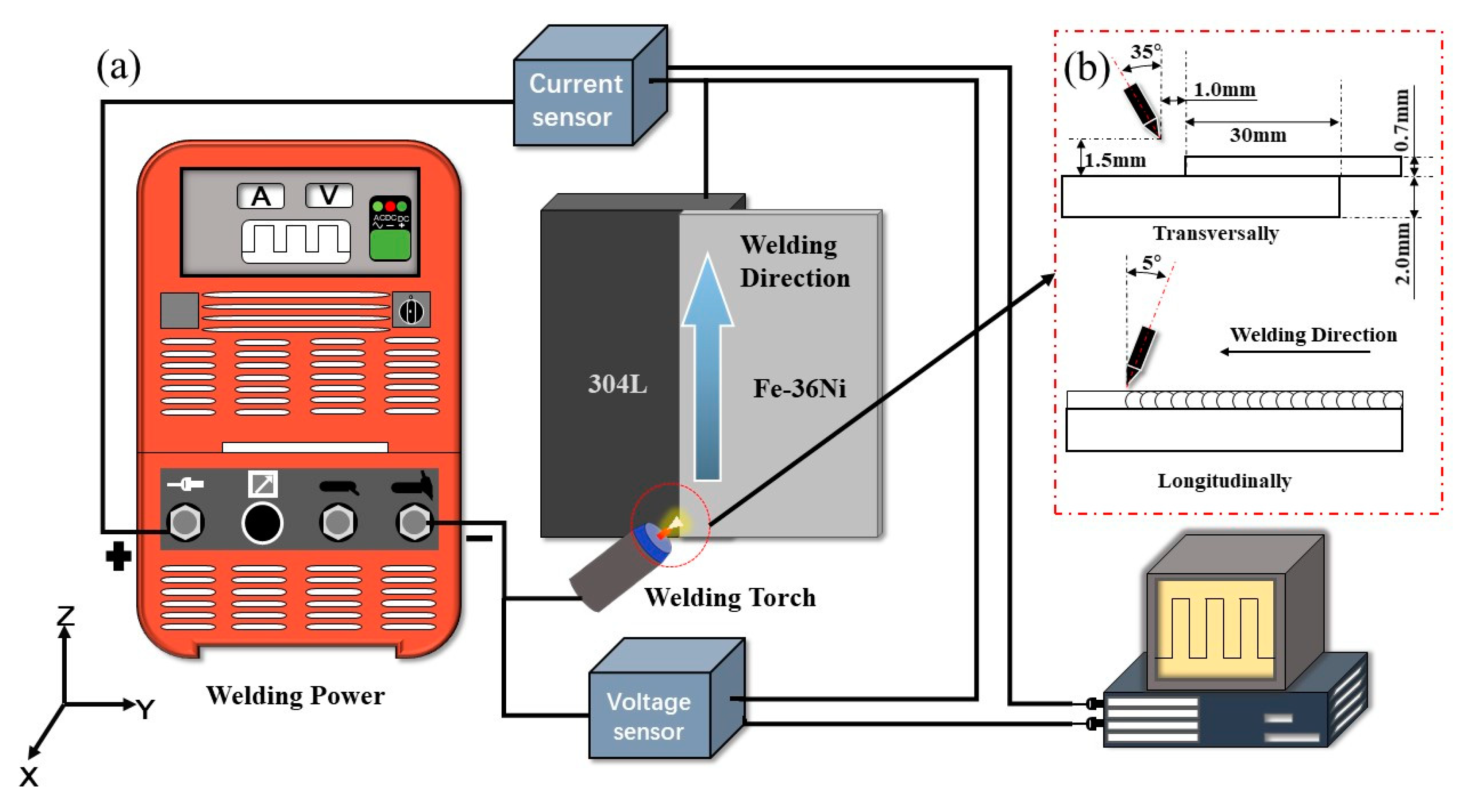
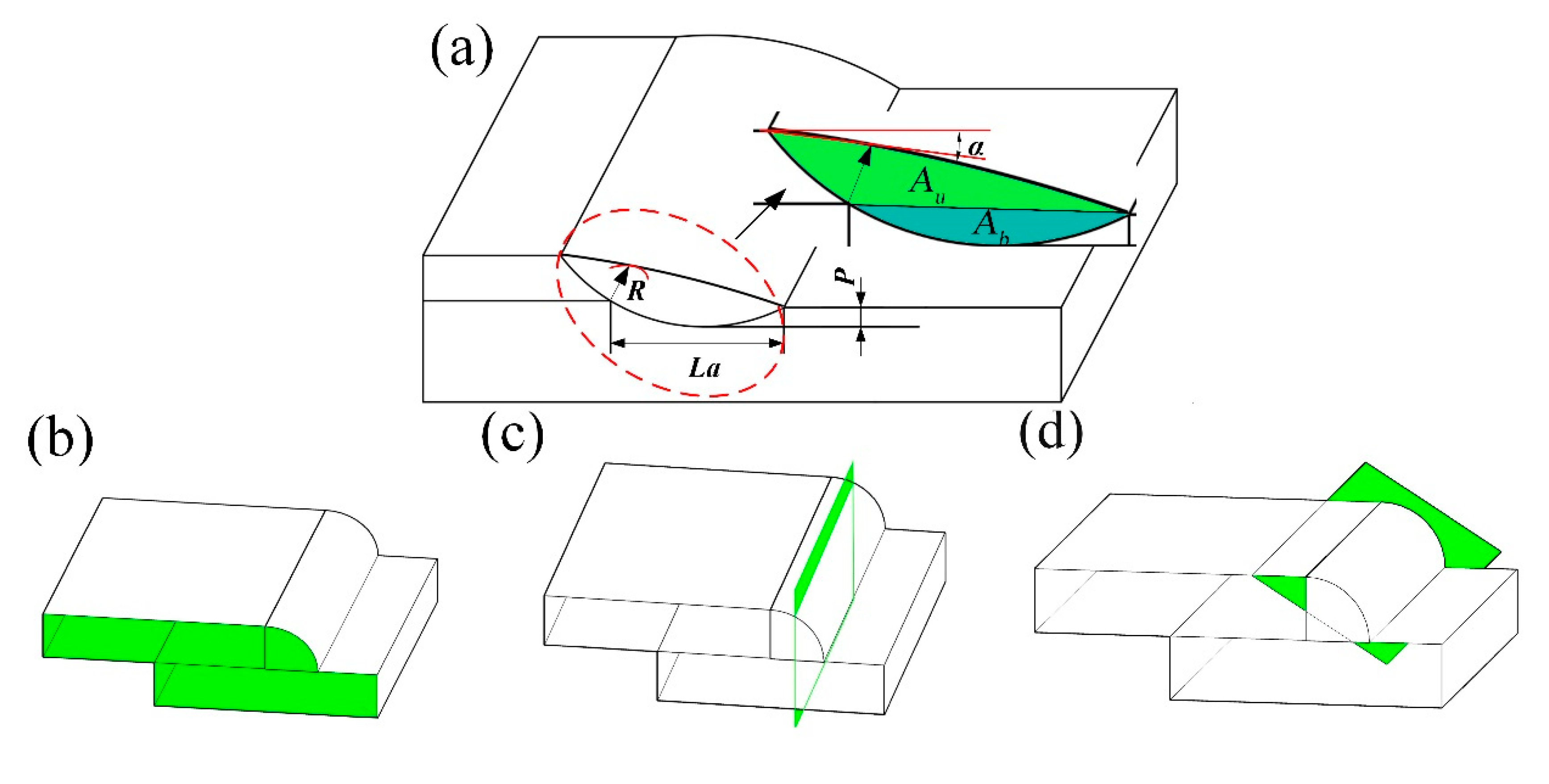

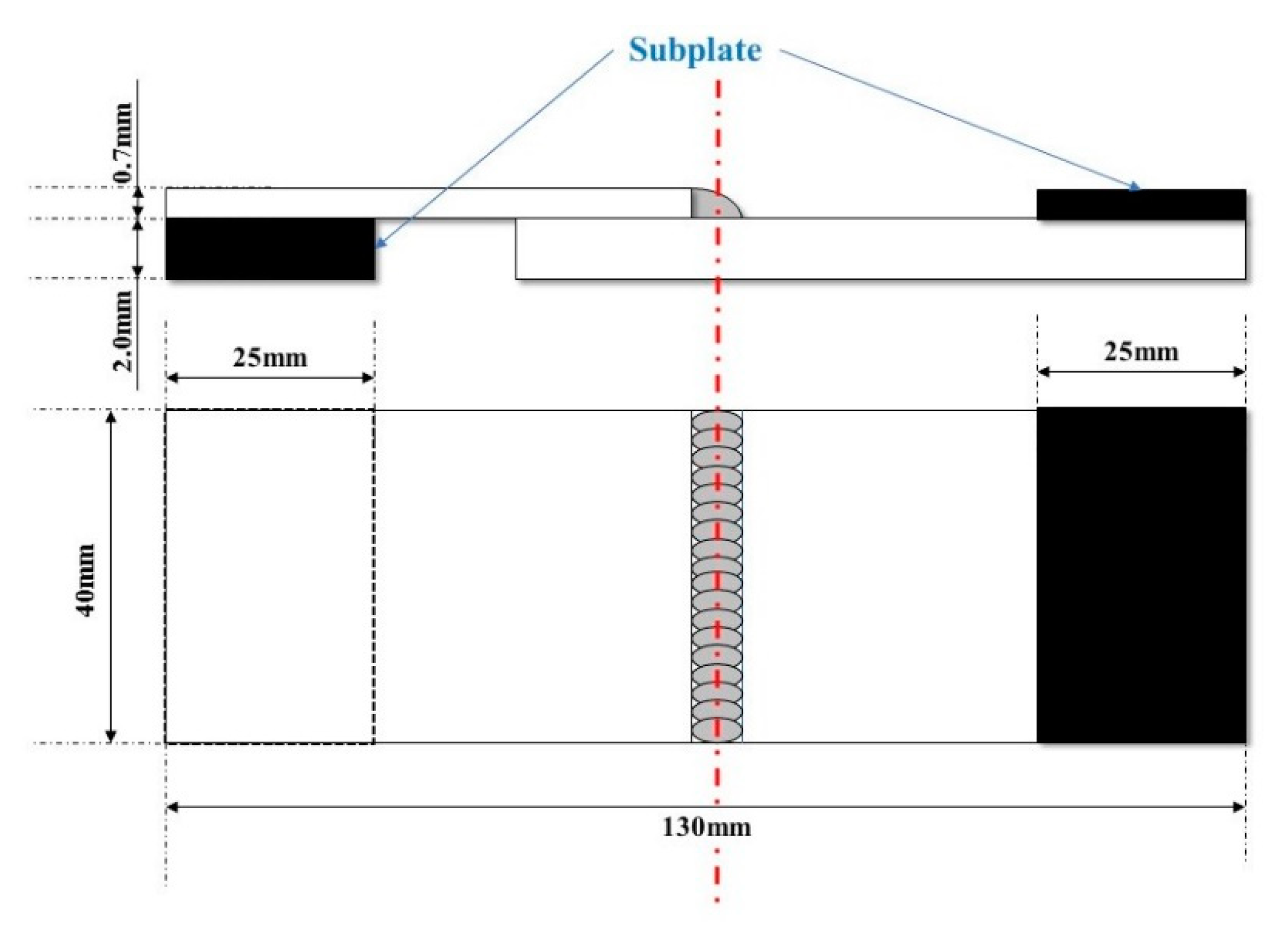
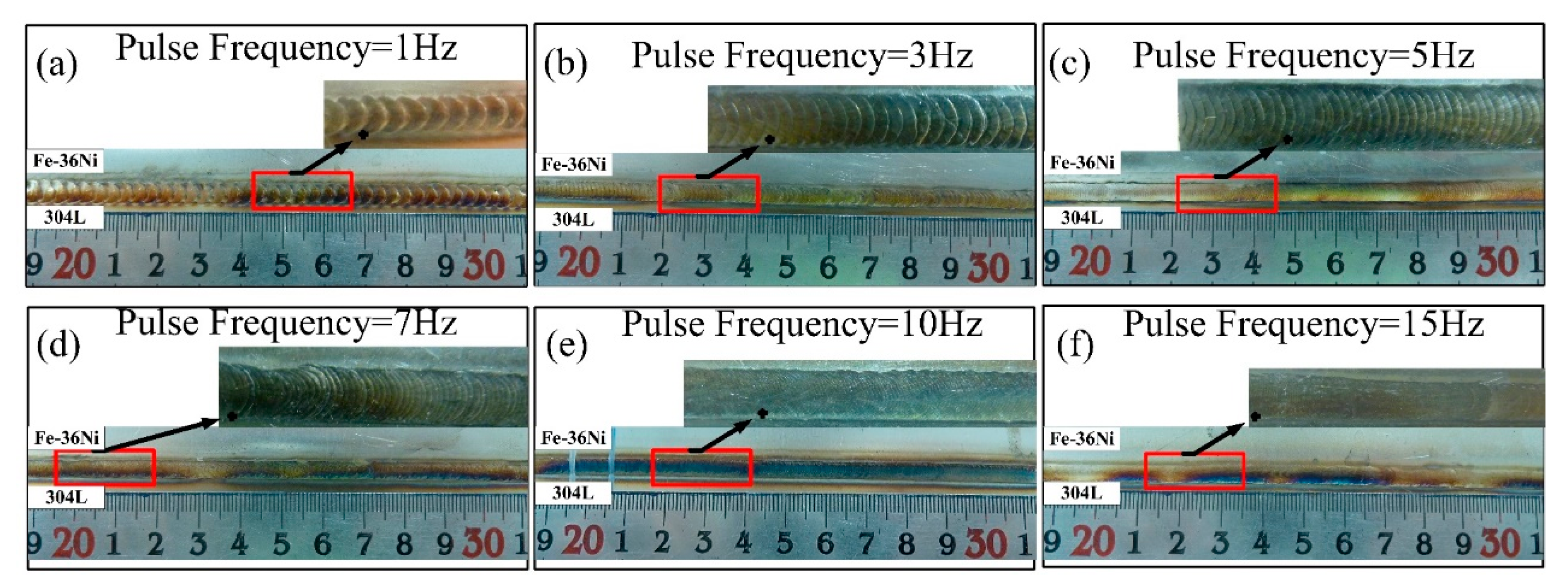

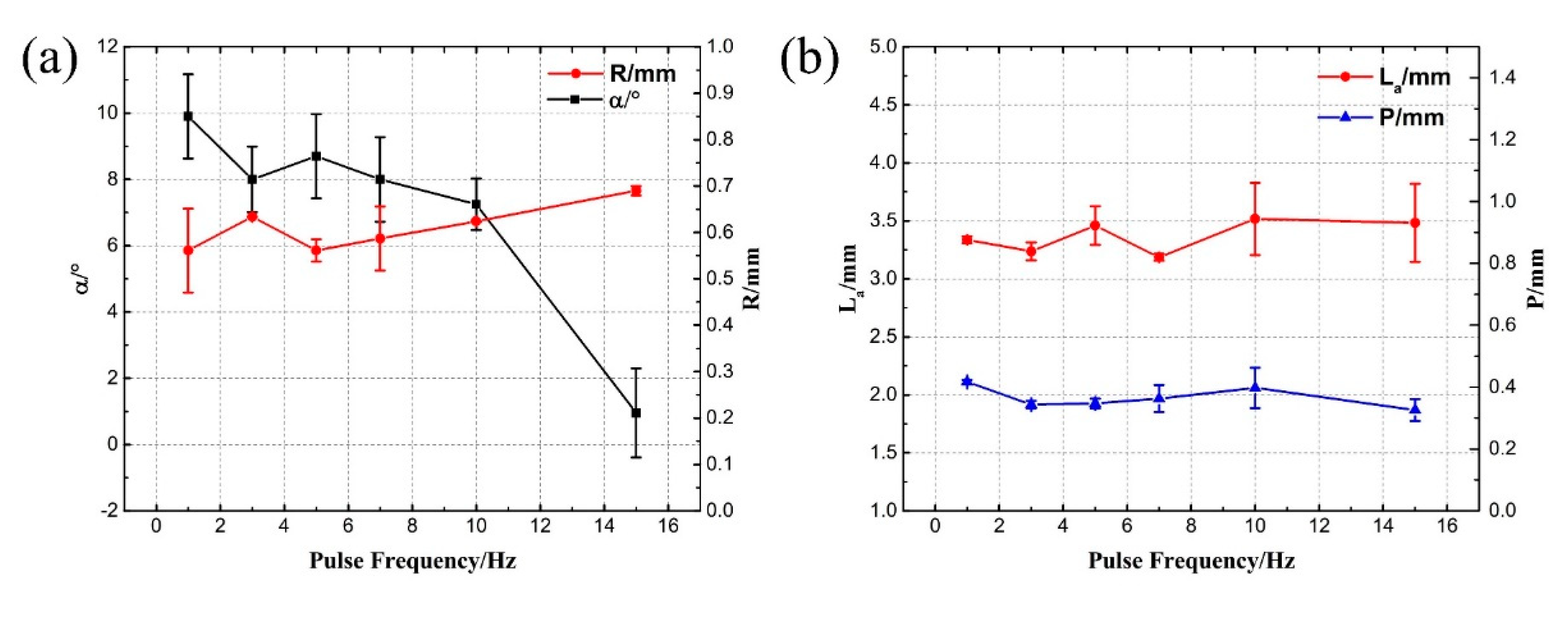
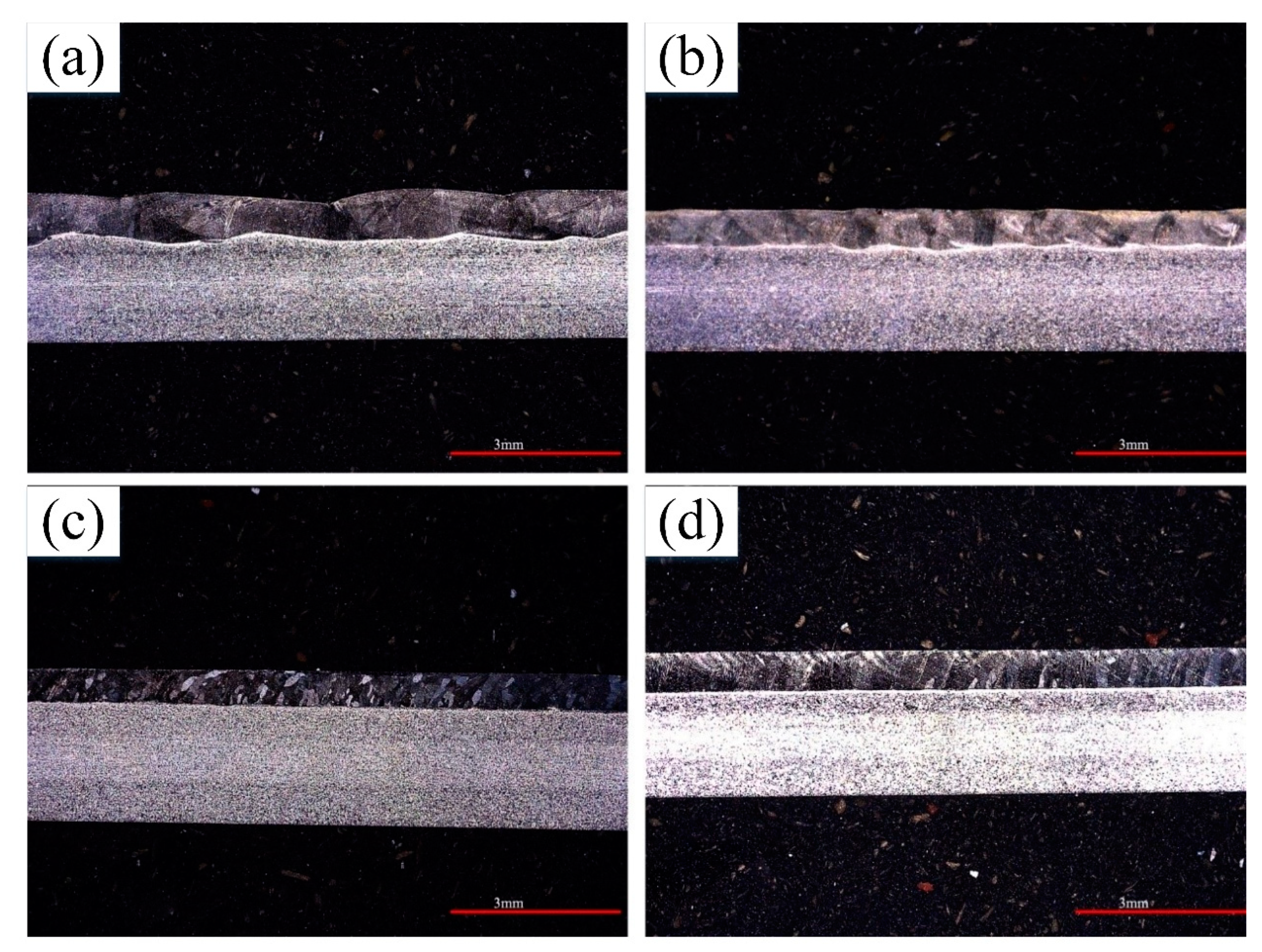
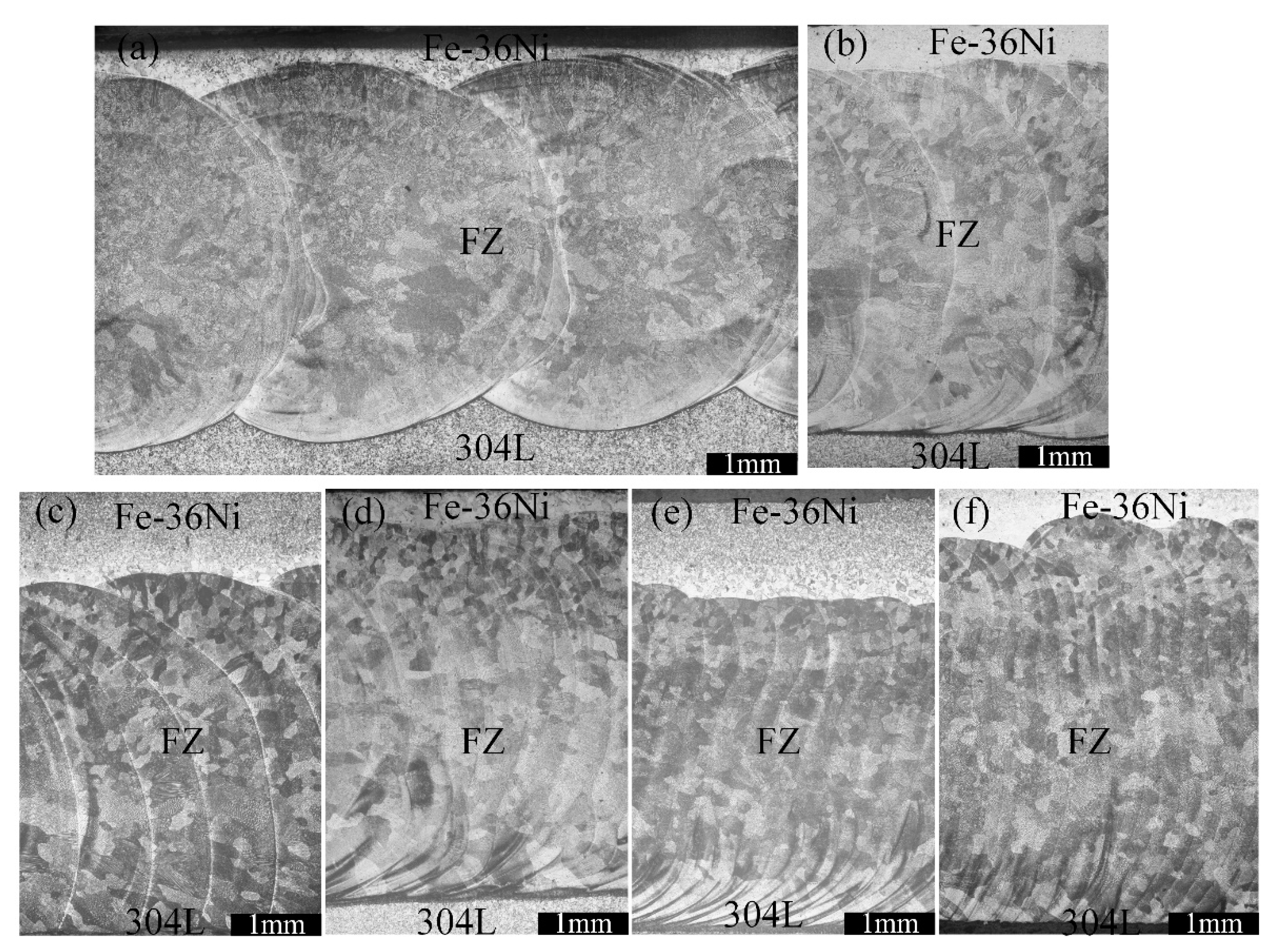
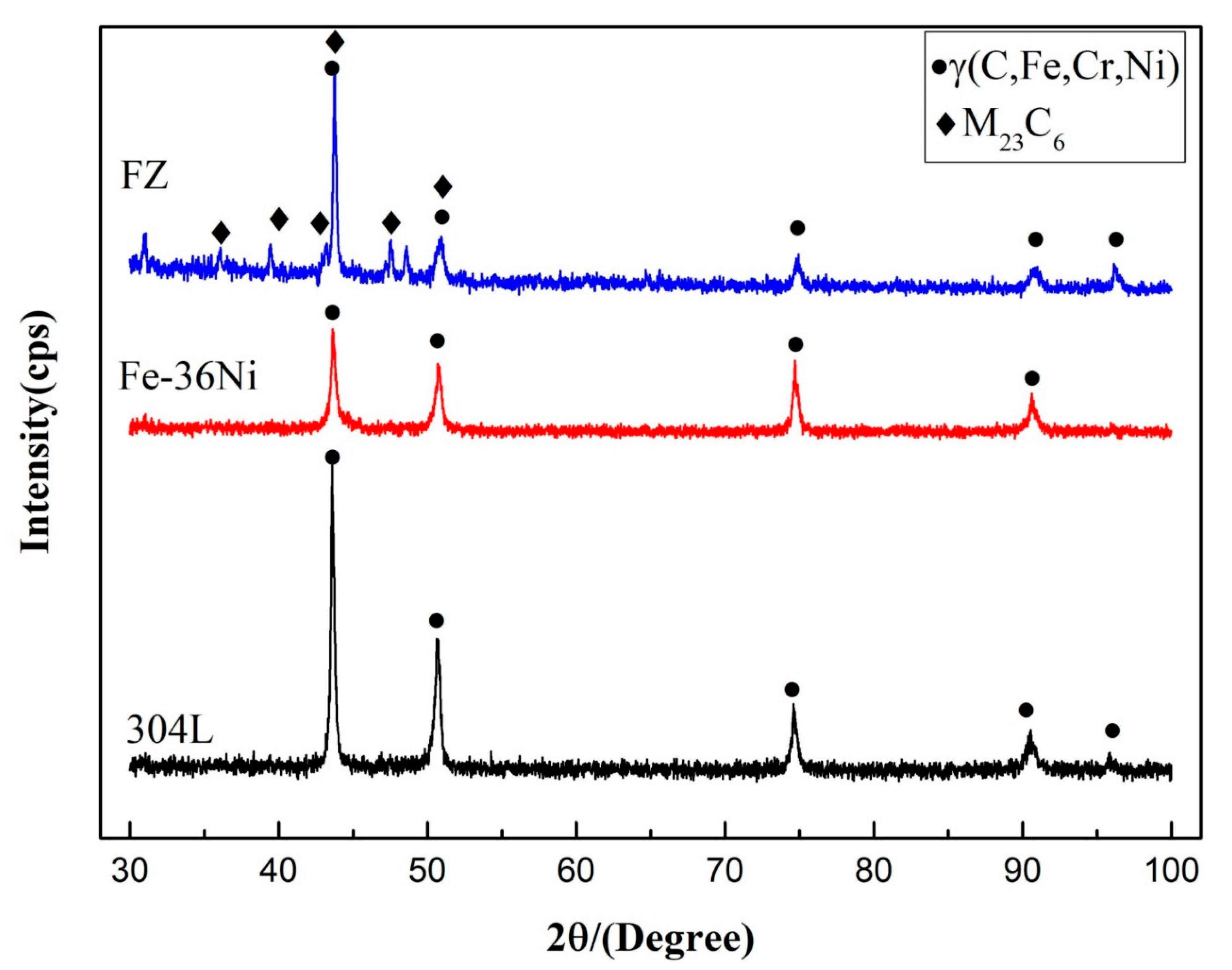

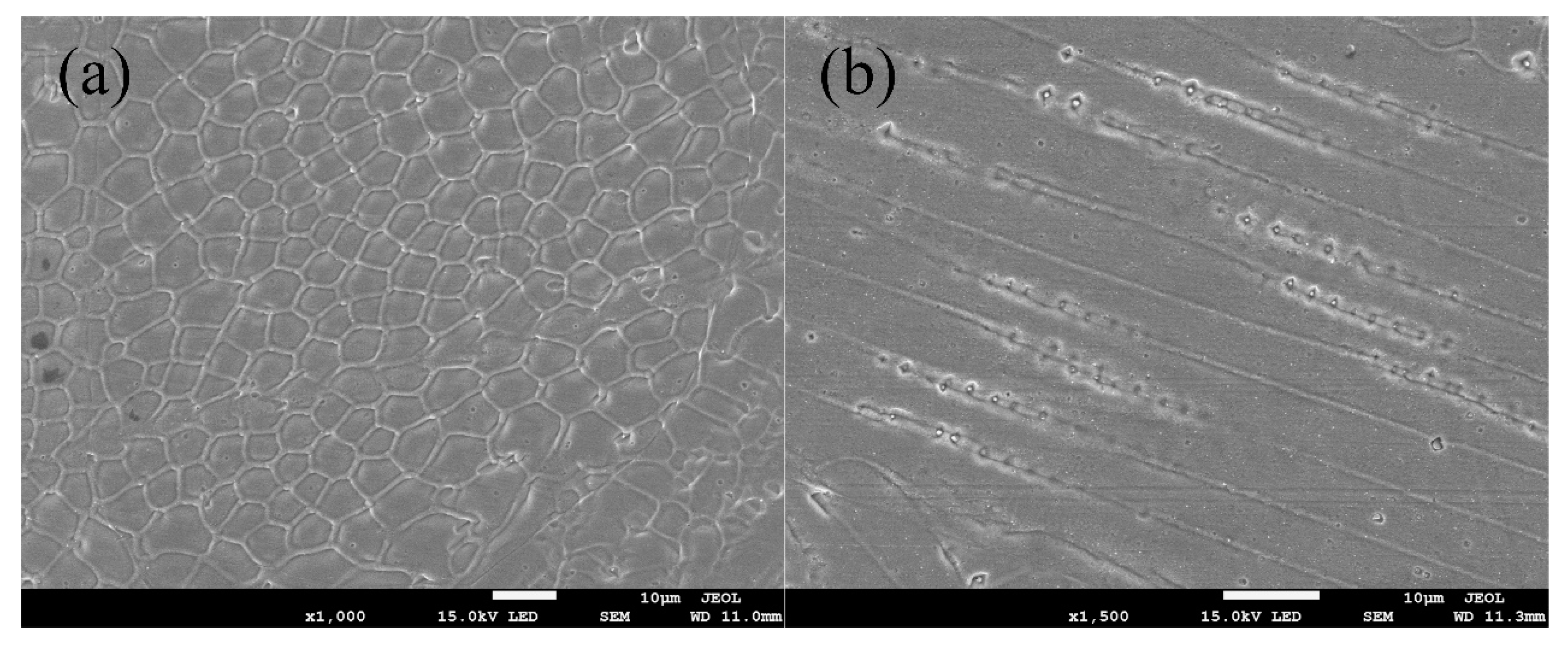
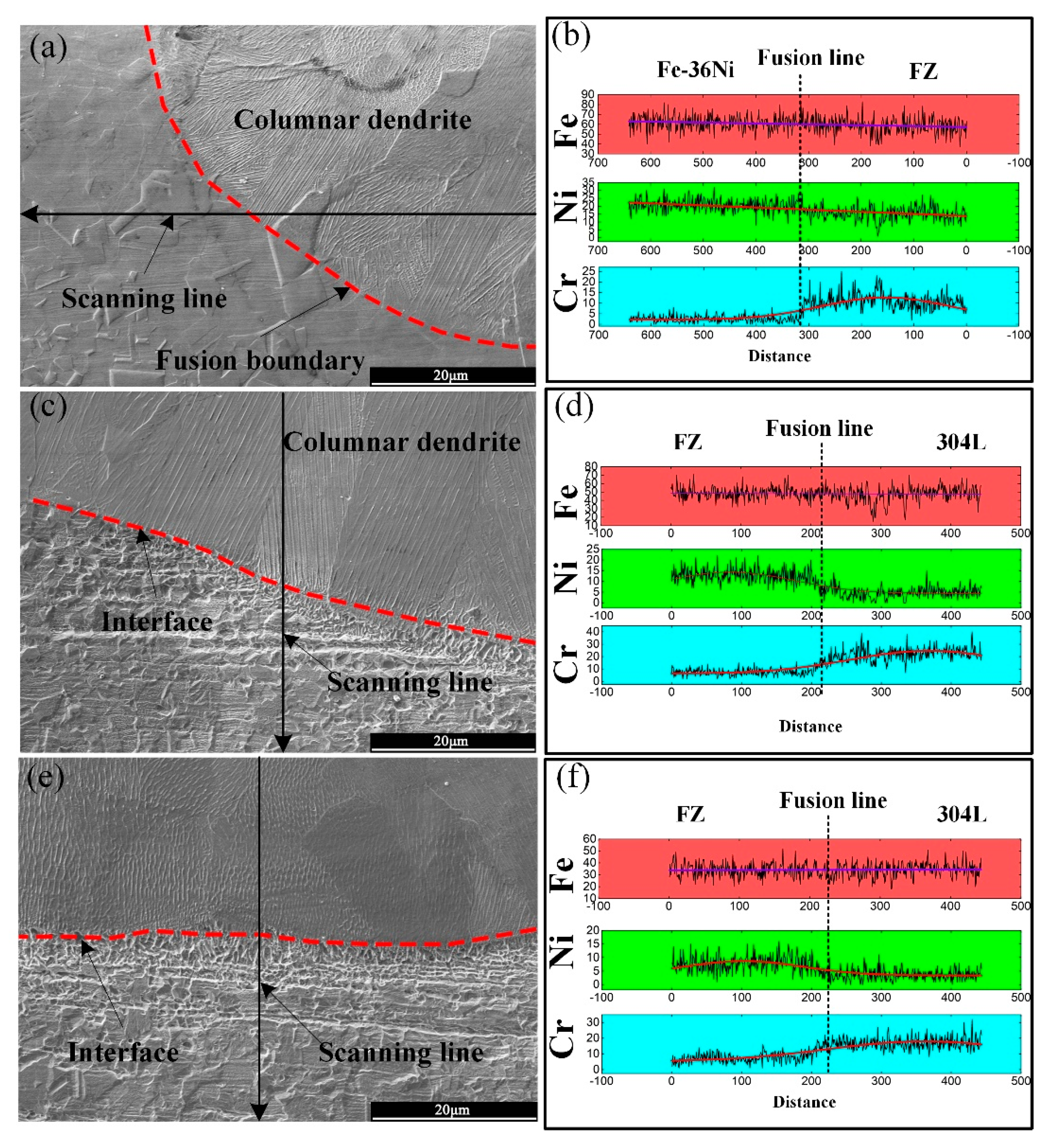
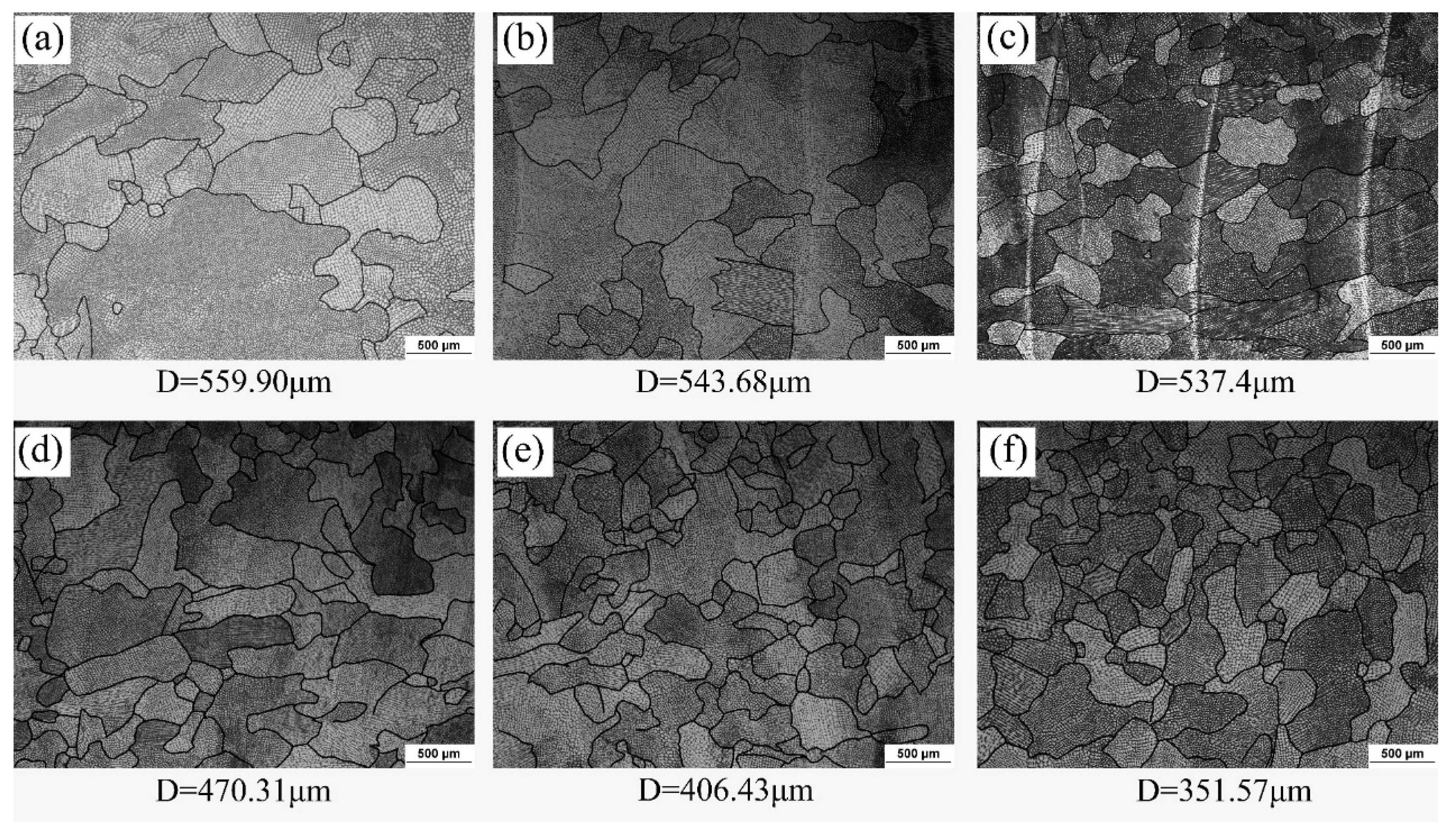
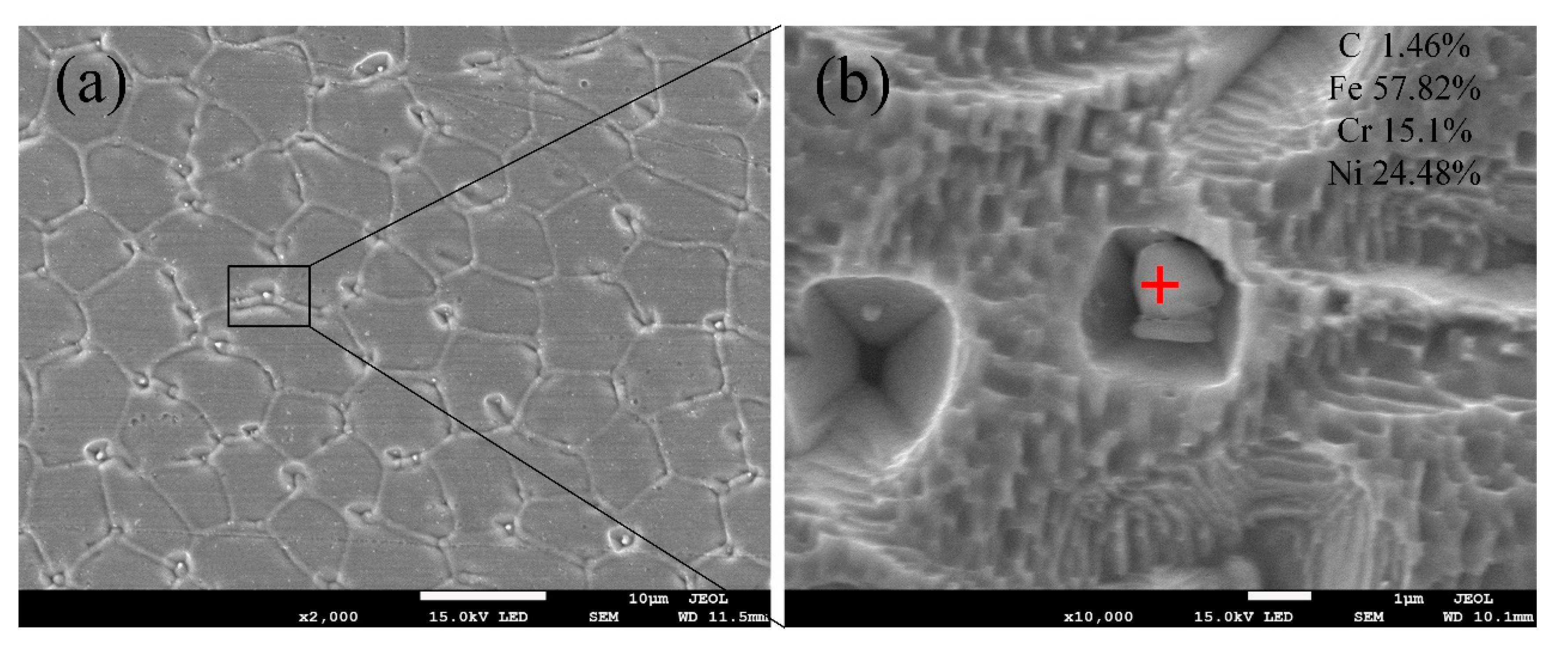
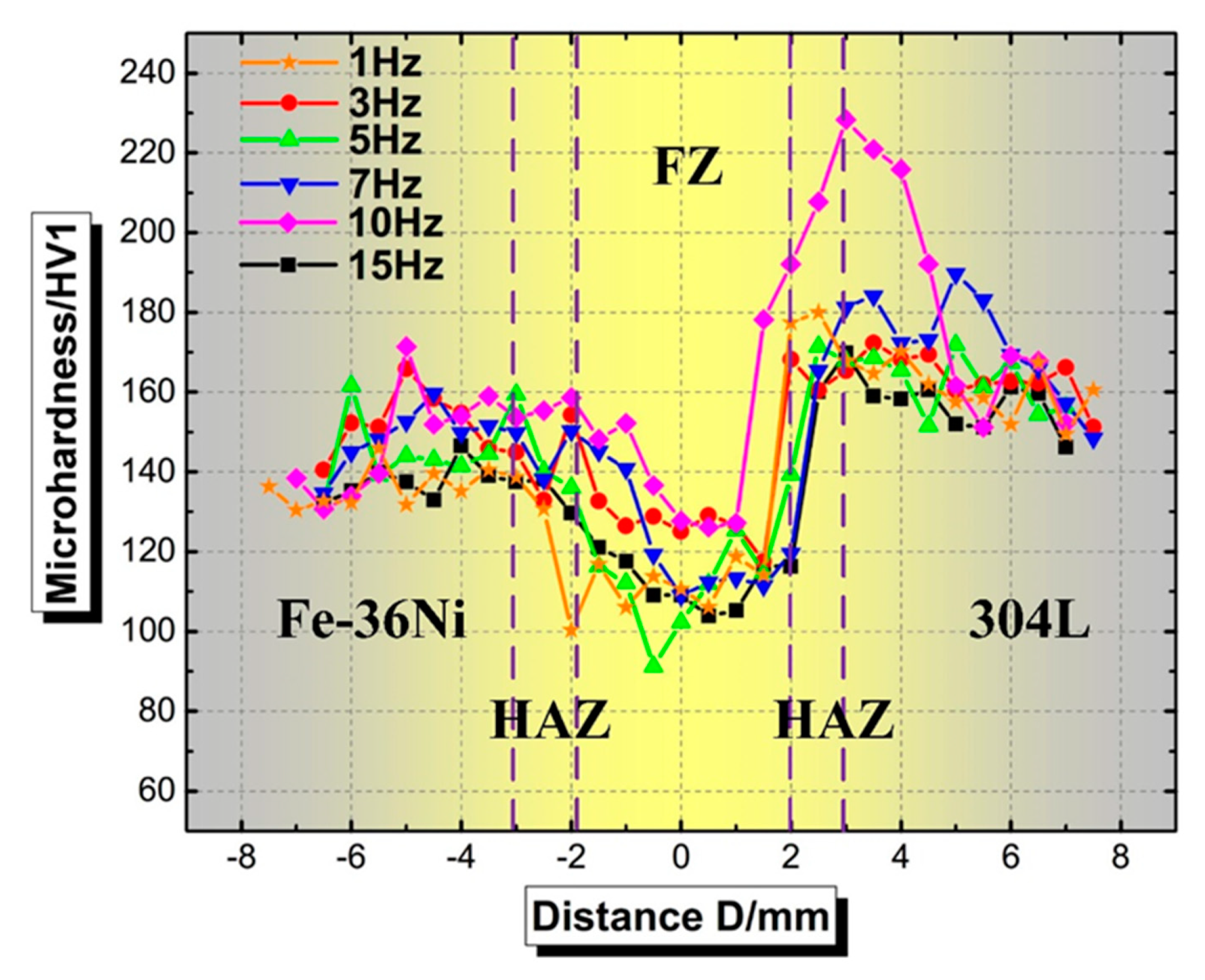

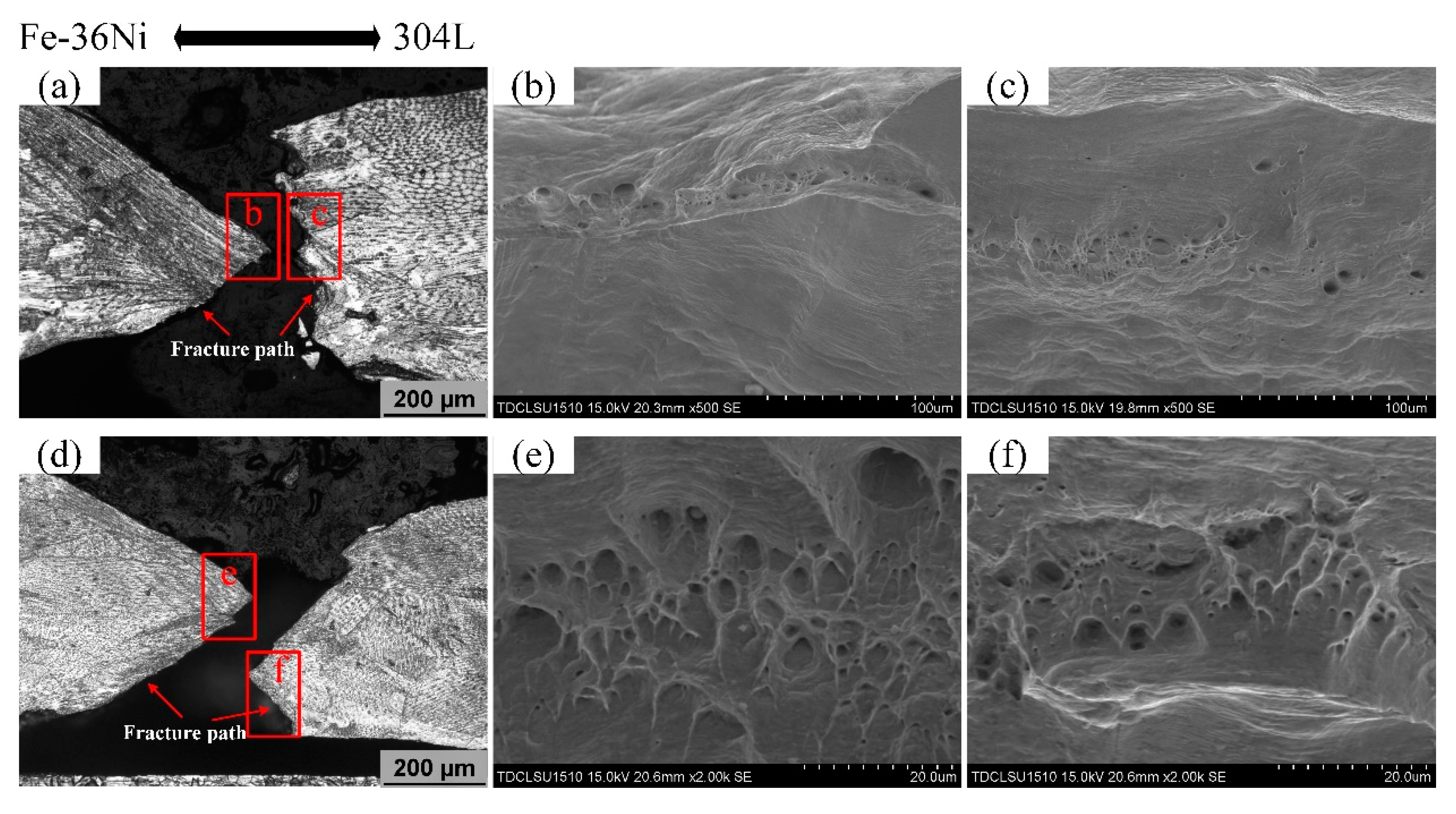
| Element | C | P | S | Si | Mn | Ni | Cr | Fe |
|---|---|---|---|---|---|---|---|---|
| Fe-36Ni | ≤0.05 | ≤0.02 | ≤0.02 | ≤0.2 | 0.2–0.6 | 35.0–37.0 | - | Bal |
| 304L | 0.03 | 0.04 | 0.03 | 0.75 | 2 | 8.0–12.0 | 18.0–20.0 | Bal |
| Peak Current/ (A) | Base Current/ (A) | Duty Cycle/ (%) | Pulse Frequency/ (Hz) | Welding Speed/ (mm∙min−1) | Gas Flow/ (L∙min−1) | Average HI/ (J∙mm−1) |
|---|---|---|---|---|---|---|
| 100 | 12 | 55 | 1 | 200 | 15 | 199.48 |
| 3 | 202.75 | |||||
| 5 | 205.25 | |||||
| 7 | 201.47 | |||||
| 10 | 197.52 | |||||
| 15 | 201.23 |
| Pulse Frequency | C | Ni | Cr | Fe | Si | Mn | D% |
|---|---|---|---|---|---|---|---|
| 1 | 0.03 | 27.50 | 6.89 | 63.46 | 0.38 | 0.80 | 0.66 |
| 3 | 0.03 | 27.73 | 6.73 | 63.40 | 0.37 | 0.78 | 0.67 |
| 5 | 0.03 | 27.12 | 7.15 | 63.57 | 0.39 | 0.82 | 0.65 |
| 7 | 0.03 | 28.69 | 6.06 | 63.12 | 0.36 | 0.72 | 0.71 |
| 10 | 0.03 | 28.56 | 6.15 | 63.161 | 0.36 | 0.73 | 0.71 |
| 15 | 0.03 | 30.0 | 5.09 | 62.7 | 0.33 | 0.63 | 0.76 |
| Sample | F (kN) | Fracture Location |
|---|---|---|
| 1 Hz | 10.85 | Weld Root |
| 3 Hz | 11.14 | Weld Root |
| 5 Hz | 11.01 | Weld Root |
| 7 Hz | 11.13 | Weld Root |
| 10 Hz | 11.15 | Weld Root |
| 15 Hz | 11.95 | Weld Root |
© 2020 by the authors. Licensee MDPI, Basel, Switzerland. This article is an open access article distributed under the terms and conditions of the Creative Commons Attribution (CC BY) license (http://creativecommons.org/licenses/by/4.0/).
Share and Cite
Wang, Q.; Shen, J.; Hu, S.; Zhao, G.; Zhou, J. Microstructure and Mechanical Properties of Fe-36Ni and 304L Dissimilar Alloy Lap Joints by Pulsed Gas Tungsten Arc Welding. Materials 2020, 13, 4016. https://doi.org/10.3390/ma13184016
Wang Q, Shen J, Hu S, Zhao G, Zhou J. Microstructure and Mechanical Properties of Fe-36Ni and 304L Dissimilar Alloy Lap Joints by Pulsed Gas Tungsten Arc Welding. Materials. 2020; 13(18):4016. https://doi.org/10.3390/ma13184016
Chicago/Turabian StyleWang, Qian, Junqi Shen, Shengsun Hu, Guancheng Zhao, and Jie Zhou. 2020. "Microstructure and Mechanical Properties of Fe-36Ni and 304L Dissimilar Alloy Lap Joints by Pulsed Gas Tungsten Arc Welding" Materials 13, no. 18: 4016. https://doi.org/10.3390/ma13184016





